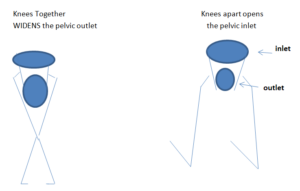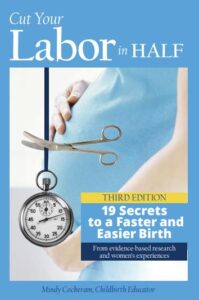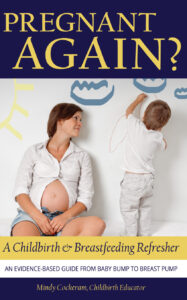.
Private Childbirth & Breastfeeding Education
Providing private in-person and virtual Childbirth & Breastfeeding Classes for a positive birth experience. Click Private Class Enquiry for more information.
For as long as I can remember, I (and probably you) have been encouraging birthing people to adopt upright, forward and open positions (so-called ‘UFO Positions’) in labor in order to make as much space in the pelvis as possible. “Open the inlet” has always been my mantra along with many other educators, midwives and L&D nurses. When peanut balls began appearing in labor rooms five or so years ago – with great success in supporting both dilation and descent – we hailed the mighty peanut as the next great birthing in(ter)vention to avoid “failure to progress.” After all, riding the peanut ball between the thighs keeps the knees apart with (or without) an epidural and allows the baby to descend into a welcoming wide pelvis. Pushing the baby out in those same kinds of positions has always been the norm.
This is why I was surprised when I read about the success of ‘knees together’ (KT) pushing positions on many of the Facebook groups to which I belong. “Mom had been pushing for 2 hours and it was starting to look doubtful… so when the Doc briefly left the room we tried three KT pushes and the baby flew out” or “I’ve been so successful with this that our MDs are now on board!” or “Today we used the knees together, feet out pushing position with a suspected OP and it worked amazingly.” Anecdotal information of quick results aside, what exactly is the basis for throwing out everything we know about standard 90° angle, legs apart pushing positions – especially when one can find no evidence based studies to support the knees together technique?
To find the answer, I first went back to the anatomy of the pelvis. Despite four distinct female pelvis shapes, they have a lot in common. Generally, the entrance or inlet (aka brim) of the pelvis is wider side to side averaging 13cm transversely and 11cm front to back. The middle of the pelvis is slightly more round but begins to narrow – much like a funnel. Finally the pelvic outlet is oval but widest (averaging 12.5cm) from front to back and 10.5cm transversely. Traditional pushing positions with the knees apart increase (open) the diameter of the inlet. But the outlet can also be made larger depending on the movement of the thighs (femur bones). So let’s say a baby is comfortably deep in the mid pelvis sitting at a fetal station of +1 and the parent has been pushing with little progress – even after laboring down. Although we teach and encourage alternative pushing positions, we know that a large majority of people end up pushing while lying on their sacrum (thereby reducing the front to back space of the outlet). Is there a way to make more room in the pelvic outlet from side to side in any position? Enter ‘knees together’ (KT) pushing.
To further explore the knees together concept, my second port of call was to midwife Gail Tully of Spinning Babies. According to Gail, if the care provider has sight of the baby’s head but the baby just isn’t moving down, “..in any position, put your knees together! Yes! Knees together and heels apart. Point your toes at each other. If on your side, it will basically be turning one thigh and foot into this position.” Putting the knees together opens the pelvic outlet across the more narrow part of the oval. However Gail cautions that there is an optimal time to push this way: “If they say baby is still high and we’re waiting for baby to come around the bend or under the bone then opening your knees is suitable”.

©Krislyn Griffin. Used with permission
With stories of knees together pushing continuing to spread across social media, one wonders if a proper study is not far off. As I stood in the shower a few weeks ago with my hands on my ischial tuberosities (sitz bones) rotating my femurs in my own knees together in order to personallyexperiment, I could easily feel the expansion. For a better visual of the rotation and useful ways to facilitate knees together pushing using the peanut ball, see the photos on the website Mamastefit.

I have now incorporated Knees Together pushing into my Lamaze course when explaining BRAIN, display a visual when we cover 2nd stage and ask everyone to try the same shower experiment. Have you encouraged or witnessed knees together pushing with a good result? Have you seen any evidence based research or literature on Knees Together pushing? Have you now included this technique in your childbirth classes? Can you share some images or success stories in our comments below?
Illustrated drawing courtesy of the Royal College of Midwives Normal Birth Campaign, 2011
Mamastefit. Feb 2019. The Pelvic Outlet: Anatomy and Movement Support. www.mamastefit.com/blog/2019/2/14/the-pelvic-outlet-anatomy-amp-movement-support. Accessed Dec 2019.
Paterson-Brown Sara. 2010. Basic Science in Obstetrics and Gynaecology (Fourth Edition). Chapter 5 Applied Anatomy. Pg 66-68.
Tully, Gail. (undated) Walcher’s: Open the Brim. www.spinningbabies.com. Accessed Dec 2019.
Tully, Gail. July, 2019. Prevent Tearing During Childbirth. www.spinningbabies.com. Accessed Dec 2019.
Tully, Gail. Feb, 2016. Maternal Positioning Needs Better Understanding. www.spinningbabies.com. Accessed Dec 2019.
This article was originally written for Lamaze International’s Educator Blog Connecting The Dots and published in Jan 2020. Narrow the Knees to Push with Ease: Challenge The Norm and Get The Job Done! (lamaze.org)
For more information on pushing in the 2nd stage of labor, read Chapter 14 – Get Pushy when Pushing – in Cut Your Labor in Half: 19 Secrets to a Faster and Easier Birth (on Amazon.com or BN.com).
Click to explore


Sorry, comments are closed for this post.